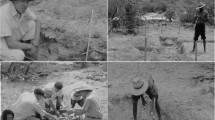Abstract
The period of the Atlantic slave trade between Africa and European colonies is relatively well documented compared with the historic records of many regions of precolonial Africa. However, this documentation necessarily presents a perspective distilled through European eyes. This paper suggests a methodology influenced byAnnales history for critically analyzing documentary sources in conjunction with a critical interpretation of archaeological remains. Archaeological evidence from recent excavations at the site of Savi, capital of the Hueda kingdom, is contrasted with documentary evidence, facilitating an interpretation of motivations guiding Hueda interaction with European traders and structuring their spatial relationship.
Similar content being viewed by others
References Cited
Agbaje-Williams, B. (1989). Archaeological reconnaissance of Ipapo Ile, Kwara State Nigeria: an interim report.West. African Journal of Archaeology 19: 21–36.
Agbaje-Williams, B. (1990). Oyo ruins of NW Yorubaland, Nigeria.Journal of Field Archaeology 17: 367–373.
Aguigah, D. A. (1989). Recherches archéologiques & historiques à Notsé & Tado: résultats & perspectives. In Kuevi, D. A., and Aguigah, D. A. (eds.),Actes de la Quinzaine de l'Archélogie Togolaise 10 Janvier-4 Février, LAssociation Togolaise de la Recherche Scientifique, Lomé, pp. 46–65.
Bintliff, J. (ed.) (1991)The Annales School and Archaeology, Leicester University Press, London.
Bosman, W. (1705).A New and Accurate Description of the Coast of Guinea, Divided into the Gold, the Slave, and the Ivory Coasts, London.
Connah, G. (1975).The Archaeology of Benin, Clarendon Press, Oxford.
Curtin, P. (1975).Economic Change in Precolonial Africa: Senegambia in the Era of the Slave Trade, University of Wisconsin Press, Madison.
DeCorse, C. R. (1989).An Archaeological Study of Elmina, Ghana: Trade and Culture Change on the Gold Coast Between the Fifteenth and Nineteenth Centuries Ph.D. dissertation, University of California, Los Angeles.
DeCorse, C. R. (1992). Culture contact, continuity, and change on the Gold Coast: AD 1400–1900.African Archaeological Review 10: 163–196.
DeMarrais, E., Castillo, L. J., and Earle, T. (1996). Ideology, materialization, and power strategies.Current Anthropology 37: 15–31.
Drescher, S. (1992). The ending of the slave trade and the evolution of European scientific racism. In Inikori, J. E., and Engerman, S. L. (eds.),The Atlantic Slave Trade: Effects on Economies, Societies, and Peoples in Africa, the Americas, and Europe, Duke University Press, Durham, NC, pp. 361–396.
Gayibor, N. L. (1977).Recueil des Sources Orales du Pays Aja-Ewe, L'Institut Pédagogique National, Lomé, Togo.
Gayibor, N. L. (1985),L'Aire Culturelle Ajatado des Origines à la Fin du XVIIIè Siècle, Ph.D. Dissertation, Université de Paris I, Panthéon, Sorbonne.
Jones, A. (1985).Brandenburg Sources for West African History: 1680–1700, Franz Steiner Verlag Weisbaden GMBH, Stuttgart.
Jones, A. (1988). Drink deep, or taste not: Thoughts on the use of early European records in the study of African material culture. InConference and Workshop on African Material Culture, Bellagio, Italy, pp. 111–113.
Karl-Augustt, E. (1985). Origine des Houéda. Problématique et essai de synthèse. In Union Generale pour le Développement de Ouidah (U.G.D.O.) (ed.),Les Voies de le Renaissance de Ouidah, Editions KANTA, Caen, pp. 61–82.
Kea, R. A. (1982).Settlements, Trade and Polities in the Seventeenth-Century Gold Coast, The Johns Hopkins University Press, Baltimore.
Kelly, K. G. (1994). Recent excavations at Savi: An eighteenth century West African trade town.Nyama Akuma 41: 2–8.
Kelly, K. G. (1995).Transformation and Continuity in Savi, a West African Trade Town: An Archaeological Investigation of Culture Change on the Coast of Bénin During the 17th and 18th Centuries, PhD. dissertation, University of California, Los Angeles.
Kelly, K. G. (1997a) The archaeology of African-European interaction: Investigating the social roles of trade, traders, and the use of space in the seventeenth and eighteenth century Hueda kingdom, Republic of Bénin,World Archaeology 28: 77–95.
Kelly, K. G. (1997b). Change and continuity in coastal Bénin. In DeCorse, C. R. (ed.),Historical Archaeology in West Africa: Culture Contact, Continuity, and Change, Smithsonian Institution Press, Washington, DC. (in press).
Knapp, A. B. (ed.) (1992),Archaeology, Annales, and Ethnohistory, Cambridge University Press, Cambridge.
Kuevi, D. A. (1989). Vestiges et monuments anciens sur le Plateau de Danyi. In Kuevi, D. A., and Aguigah, D. A. (eds.),Actes de la Quinzaine de l'Archéologie Togolaise 10 Janvier-4 Février, L'Association Togolaise de al Recherche Scientifique, Lomé, pp. 66–78.
Labat, J.-B. (1731).Voyage du Chevalier des Marchais en Guinée, isles voisines et à Cayenne, fait en 1725, 1726 et 1727, Amsterdam.
Law, R. (1989).Correspondence from the Royal African Company's Factories at Offra and Whydah on the Slave Coast of West Africa in the Public Record Office, London, 1678–93. Centre of African Studies, Edinburgh.
Law, R. (1991a).Correspondence of the Royal African Company's Chief Merchants at Cabo Corso Castle with William's Fort, Whydah, and the Little Popo Factory, 1727–1728: An Annotated Transcription of Ms. Francklin 1055/1 in the Bedfordshire County Record Office, University of Wisconsin Press, Madison.
Law, R. (1991b).The Slave Coast of West Africa, 1550–1570: The Impact of the Atlantic Slave Trade on an African Society, Clarendon Press, Oxford.
Metcalf, G. (1987). A microcosm of why Africans sold slaves: Akan consumption patterns in the 1770s.Journal of African History 28: 377–394.
Peebles, C. S. (1991). Annalistes, hermeneutics and positivists: Squaring circles or dissolving problems. In Bintliff, J. (ed.),The Annales School and Archaeology, Leicester University Press, London, pp. 108–124.
Posnansky, M. (1981). Notsé town wall survey.Nyame Akuma 18: 56–57.
Posnansky, M. (1985). Togo and new directions in the study of West Africa's past. InActes du Séminaire UCLA-UB sur les Sciences Sociales, Université du Bénin, Lomé.
Quarcoopome, N. O. (1993). Notse's ancient kingship: Some archaeological and art historical considerations.African Archaeological Review 11: 109–128.
Richardson, D. (1979). West African consumption patterns and their influence on the 18th century English Slave Trade. In Gemery, H. A., and Hogendorn, J. S. (eds.),The Uncommon Market: Essays in the Economic History of the Atlantic Slave Trade, Academic Press, New York, pp. 303–330.
Smith, M. (1992). Braudel's temporal rhythms and chronological theory in archeology. In Knapp, A. B. (ed.),Archaeology, Annales, and Ethnohistory, Cambridge University Press, Cambridge, pp. 23–34.
Smith, W. [1744 (reissued 1967)].A, New Voyage to Guinea, Frank Cass & Co., London.
Snelgrave, W. (1734).A New Account of Some Parts of Guinea and the Slave Trade, J. & J. Knapton, London.
Snodgrass, A. (1991). Structural history and classical archaeology. In Bintliff, J. (ed.),The Annales School and Archaeology, Leicester University Press, London, pp. 57–72.
van Dantzig, A. (1978).The Dutch and the Guinea Coast, 1674–1742: A Collection of Documents from the General State Archive at the Hague, Ghana Academy of Arts and Sciences, Accra.
Verger, P. (1976).Trade Relations Between the Bight of Benin and Bahia from the 17th to 19th Century, Ibadan University Press, Ibadan.
Whitehead, N. L. (1995). The historical anthropology of text: The interpretation of Ralegh'sDiscoverie of Guiana.Current Anthropology 36: 53–74.
Wood, W. R. (1967). An archaeological appraisal of early European settlements in the Senegambia.Journal of African History 8: 39–64.
Author information
Authors and Affiliations
Rights and permissions
About this article
Cite this article
Kelly, K.G. Using historically informed archaeology: Seventeenth and eighteenth century Hueda/European interaction on the coast of Bénin. J Archaeol Method Theory 4, 353–366 (1997). https://doi.org/10.1007/BF02428068
Issue Date:
DOI: https://doi.org/10.1007/BF02428068




